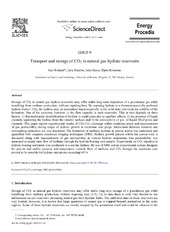| dc.contributor.author | Ersland, Geir | eng |
| dc.contributor.author | Husebø, Jarle | eng |
| dc.contributor.author | Graue, Arne | eng |
| dc.contributor.author | Kvamme, Bjørn | eng |
| dc.date.accessioned | 2015-04-16T13:08:54Z | |
| dc.date.available | 2015-04-16T13:08:54Z | |
| dc.date.issued | 2009-02 | eng |
| dc.identifier.issn | 1876-6102 | en_US |
| dc.identifier.uri | https://hdl.handle.net/1956/9817 | |
| dc.description.abstract | Storage of CO2 in natural gas hydrate reservoirs may offer stable long term deposition of a greenhouse gas while benefiting from methane production, without requiring heat. By exposing hydrate to a thermodynamically preferred hydrate former, CO2, the hydrate may be maintained macroscopically in the solid state and retain the stability of the formation. One of the concerns, however, is the flow capacity in such reservoirs. This in turn depends on three factors; 1) thermodynamic destabilization of hydrate in small pores due to capillary effects, 2) the presence of liquid channels separating the hydrate from the mineral surfaces and 3) the connectivity of gas- or liquid filled pores and channels. This paper reports experimental results of CH4- CO2 exchange within sandstone pores and measurements of gas permeability during stages of hydrate growth in sandstone core plugs. Interactions between minerals and surrounding molecules are also discussed. The formation of methane hydrate in porous media was monitored and quantified with magnetic resonance imaging techniques (MRI). Hydrate growth pattern within the porous rock is discussed along with measurements of gas permeability at various hydrate saturations. Gas permeability was measured at steady state flow of methane through the hydrate-bearing core sample. Experiments on CO2 injection in hydrate-bearing sediments was conducted in a similar fashion. By use of MRI and an experimental system designed for precise and stabile pressure and temperature controls flow of methane and CO2 through the sandstone core proved to be possible for hydrate saturations exceeding 60%. | en_US |
| dc.language.iso | eng | eng |
| dc.publisher | Elsevier | en_US |
| dc.rights | Attribution-NonCommercial-NoDerivs CC BY-NC-ND | eng |
| dc.rights.uri | http://creativecommons.org/licenses/by-nc-nd/3.0/ | eng |
| dc.subject | CO2-CH4 exchange | eng |
| dc.subject | MRI | eng |
| dc.subject | Permeability | eng |
| dc.title | Transport and storage of CO2 in natural gas hydrate reservoirs | en_US |
| dc.type | Peer reviewed | |
| dc.type | Journal article | |
| dc.date.updated | 2015-03-31T14:05:42Z | en_US |
| dc.description.version | publishedVersion | en_US |
| dc.rights.holder | Copyright 2009 University of Bergen | en_US |
| dc.identifier.doi | https://doi.org/10.1016/j.egypro.2009.02.139 | |
| dc.identifier.cristin | 351824 | |
| dc.source.journal | Energy Procedia | |
| dc.source.40 | 1 | |
| dc.source.14 | 1 | |
| dc.source.pagenumber | 3477-3484 | |

